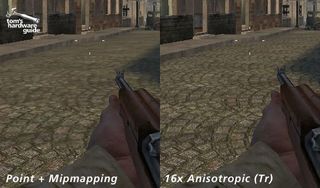ATI's Optimized Texture Filtering Called Into Question
Anisotropic Filtering

Difference between minimal and currently maximum(16x anisotropic) filtering.
The filtering method that achieves the best results today is anisotropic filtering. As the name suggests, the texels are not gleaned from a symmetrical shape, but rather by using an irregular pattern adjusted to the perspective (anisotropic shape). The form of this shape is not standardized - usually, however, rectangular or trapezoidal patterns or parallelograms are used, the shapes of which depend on the angle of the surface.

This graph shows an EWA (Ellipse Weighted Average) for texture mapping as it is used for anisotropic filtering.
The number of texels taken into account for filtering determines the filter level. With 1x, anisotropic filtering offers eight texels. With current graphics cards the filter level can be set in the driver. The maximum value is 16x, but manufacturers do not use all interim steps. The most common are: 2x (16 texels), 4x (32 texels), 8x (64 texels) and 16x (128 texels). As the filtering increases, the computing time increases accordingly, to a considerable degree.

This screenshot shows the colored mipmap levels. Left is just trilinear. On the right is 16x Anisotropic + Trilinear. You can see that the LOD is pushed backwards.
Anisotropic filtering always functions in interaction with bilinear or trilinear filtering. The bilinear variation is logically faster but has one disadvantage: the visible edge on the mipmap transitions. The best result is achieved with the more computing-intensive trilinear anisotropic filtering, in which mipmap transitions are calculated from the neighboring textures.
Stay on the Cutting Edge
Join the experts who read Tom's Hardware for the inside track on enthusiast PC tech news — and have for over 25 years. We'll send breaking news and in-depth reviews of CPUs, GPUs, AI, maker hardware and more straight to your inbox.
Current page: Anisotropic Filtering
Prev Page Bilinear And Trilinear Filtering Next Page Optimization FeverMost Popular

